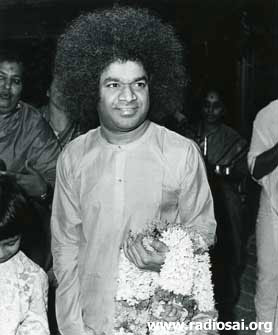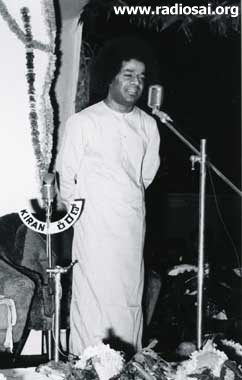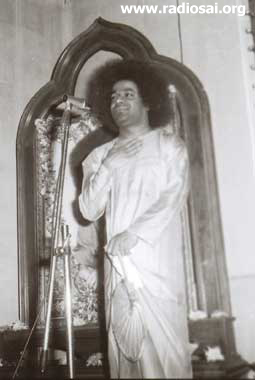Follow
Us: |
 Sai Ram Facebook |
Sai Ram Facebook |
 Twitter
| Twitter
|
 Pinterest
|
Pinterest
|
 Instagram |
Instagram |
 Tumblr |
Tumblr |
 Flickr |
Flickr |
THE
THRILLING DASARA OF THE SIXTIES
'YAGNOTSAVA'
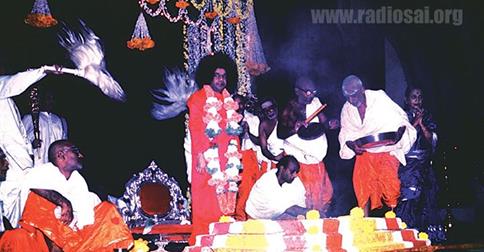
Every year during the Dasara
celebrations Puttaparthi is witness to a grand spectacle “The Veda
Purusha Sapthaha Gyana Yagna” – a Vedic sacrifice performed in the
divine presence of Bhagawan Baba for seven days. This festival in
Puttaparthi is more than six decades old. With time, celebrations
and events see a lot of change but certain things remain the same
just like the powerful and sublime nature of this sacred sacrifice.
But yes, five decades ago it had a totally different charm and it is
a very rewarding experience revisiting those golden moments when
Baba’s physical body was in its 40s. So here we have a journey into
the precious past, a riveting description of Dasara in Puttaparthi
in the words of Prof. Kasturi in the year 1962.
|
|
|
The
Rudrahoma – From a Bygone Era
It was an unforgettable
scene: the sweet melody of Nadaswaram filling the
air; the fragrance of flowers, incense, and sandalwood
wafting about; the cow with its charming little calf proud
of the necklaces, bangles and jingles it wore strutting in
front; women waving arati and holding up plates of
fruits on either side; Baba in His resplendent robe emerging
from the Prashanti Nilayam mandir with Sri Boorgala
Ramakrishna Rao and Brahmasri Kameswara Ghanapad on either
side, behind Him a bevy of a hundred ritwiks, pundits and
scholars from all parts of India, decked in multicolored
silk (each according to the function allotted to him in the
Yagna: white for those reciting the Vedas, red for those
partaking in the Rudrahoma, yellow for the others);
thousands of bhaktas, their faces bright with joy born of
the recognition of the uniqueness of the day – the day when
the Avatar of the Lord was assuming the guardianship of the
Veda-Bhaktas from Kerala to Kashmir, men, women and children
(children born in the Sai Era, blessed to spend their entire
lives in the sunshine of His Grace) – this stream of joy
moving in serene sublimity to the Yagasala; the charming
Mantapa erected with intense devotion by hands, which though
new to the task, were charged with skill and artistry by
Bhagavan Himself. The intonation of the Vedic mantras by the
entire group in ecstatic harmony thrilled every heart, for
the sacred vibration was suffused with the glory of God. |
“I Am the One Who
Accepts the Yagna”
The Yagna began at 9:30 a.m.
on the first day of October 1962. The gods were invoked and
installed and worshipped as the Vedas dictated. Athi Rudrahoma was
done, the Bhagavatham and the Ramayana and the Devi Bhagavantham
were read, the Sankarabhashyas were repeated, Suryanamaskaram with
the appropriate Vedic chants was performed, the Saligrama and the
Sahasialinga were ritually worshipped, the Yajurveda, in its two
rescensions were recited, and the Samaveda and the Atharva Veda were
chanted. The huge gathering of bhaktas sat stilled with awe and
admiration and filled their hearts with the perfume of the Sanatana
mantra. Bhagavan was present in the Yagasala every day sitting in
the midst of the Vedic pundits or moving among the bhaktas. The
hills around the Nilayam which had the privilege of echoing the
mantras will long remember the heavenly harmony of the mantra which
woke the sleeping rocks. Yes, many a stone awoke to that age-old
voice and melted at its magnificent message of hope.
|
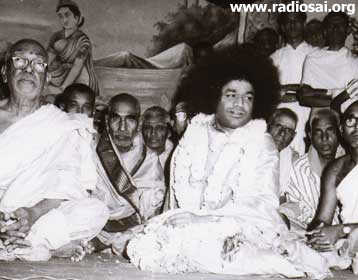 |
|
Baba said to the
assembly of ritwiks pundits and bhaktas: "I am
not the person who is doing this Yagna: I am the Person
who is accepting it." Ruminate for a moment on
that declaration and then you will realize the
atmosphere of Devaloka, of Vaikuntha itself (as some of
the eminent Vedic pundits announced) that pervaded the
Yagashala.
And the Jnana Yagna.
Every evening for eight days, from 3:30 to 8:00 p.m.,
the galaxy of pundits, from Secunderabd, Warangal,
Guntur, Rajahmundry, Amalapuram, Pithapuram, etc.,
pundits famed as specialists in scriptural lore and as
popular exponents of the Vedic message, gave the
gathering the substance of their long and arduous
studies. And the President Brahmasri Uppaluri Ganapathi
Sastri, the undisputed Master of Vedic Scholarship, in
his own effortless analytical disquisition of Vedic
mantras explained the Vedic conception of Yagna with all
its attendant rituals and the Vedic conception of
Divinity which described Baba Himself, as he realized
and revealed more and more clearly as the Yagna
proceeded.
|
Baba Will Foster and Protect the Vedas
Baba spoke at the
end of every series of speeches, summing up the
scholarly expositions in parables and stories, revealing
new facets of Dharma or lifting the veil of Maya for a
moment from His Own Mystery. He assured the
Vedic Pundits that He was on the task of
Dharmasthapana (establishing righteousness) for
which He had assumed human form; that they need no
longer pine in neglect and dishonor, that He will
provide them shade and shelter and reestablish in the
world the real value of Vedic religion. A
program of prayer and Jnana offerings was arranged
spontaneously by the pundits, with Baba seated on an
effulgent Seshathalpa, named by them, "Tribhuvana-vijaya."
It was a reminder of the Vijaya Yatra which Baba has
entered upon in answer to the prayers of good men.
Baba has often said that
He could be understood only by those who have studied
the Sastras. Bhaktas, ritwiks and pundits saw the truth
of that declaration demonstrated before them. He called,
they came; they saw, they recognized; they merged in the
sea of bhakti (devotion).
Every evening during the
Saptha (week), the pundits and scholars who
came for the Vedapurusha Jnana Yagna gave erudite
discourses and Baba elucidated the points raised by them
from the Vedas, Vedanta and Sastras.
Excerpts from Swami’s Divine Discourses on the Yagna in
1962
Baba also
emphasized many points for the uplift and correction of
the bhaktas who had gathered in the thousands:
|
|
 |
“Some critics are raising a hue
and cry that the Yagna is the occasion when a good deal of cow’s
ghee is wasted and a large quantity of sandalwood is burnt.
Perhaps they value ghee and fuel higher than life. They
calculate the price of ghee and sandalwood in rupees and paisa
and bewail the cost of these purchasable articles forgetting the
joy that is attained through the Yagna. Well, each one
of these critics has consumed so far many a bag of rice; what,
may I ask, is the great benefit they have done for mankind? How
is the world better for all the ghee that they have consumed? Do
they at least lead joyful lives? Do their relatives
lead happy lives on account of them? What is the
criteria for condemning a thing as ‘waste’? We have not asked
anyone for these articles; I am not obliged to anyone for
anything in this Yagna. No one is put to loss on this account.
It has given us and all of you great and lasting joy. Let the
critics add up the rupee value of things; we shall be happy with
the incalculable, unforgettable Ananda (bliss)
derived.”
|
|
|
Offer Your Innermost Self
“The ghee and the
sandalwood are but symbols for other more valuable
offerings, which these critics ignore. The
cow or “go” means the Jivi and since the ghee is the
most precious product of the cow, the idea
symbolized by the offering of ghee is that man must
offer his most precious treasure, the inner core of
his entire personality, to the gods. The
Adhitya (sun) is the presiding deity of the
eye and the Adhityayajna seeks to teach the need for
all eyes to cooperate in developing a united vision.
Similarly, the
Indrayajna seeks to link all hands, that is to say
all the instruments of Kriyasakthi, in one common
coordinated effort. Likewise, the Chandrayajna is an
exercise in the union of hearts and the Suryayajna
tries to symbolize the concentration of all
intellects on the solution of common problems. It is
only those who do not know the significance of Yagna
for those who participate in it and its deeper
symbolism that will drag in the jargon of the
marketplace and disparage it.”
All
Grief is Assuaged by Dharma
“Everyone is
aware of the principles of the Dharma yet they walk
in the path of Adharma. That is the tragedy. Hunger
is appeased by food; so too all grief is assuaged by
Dharma. Birth is for giving Dharma a chance. Good
deeds are Dharma, bad deeds are Adharma. So long as
there is breath in the body, Dharma must be adhered
to.
|
The animals
and birds have not deviated from their Dharma at any time; it is
only man that strays and falls. So the Avatar has to
come in human form in order to reestablish Dharma among those
who are ignoring it. Dharma and Sastra are the two bunds that
regulate the flood waters of sensual desire and egoism.”
A Warning from Swami
“I must now issue a warning.
Whenever a particular article becomes the object of
popular demand, greedy people begin to trade on it;
this is quite natural, but you should be careful not
to be duped. Now, many people have started using My
Name and trying to eke out a livelihood, moving
among devotees. Some of them say, “I have been sent
by Baba to you, to your town, to your area, in order
to spread His Name and His Glory.” Some others say,
“I have been specially blessed by Baba thus and
thus, He has revealed to me this, or He has given me
this boon.” Others say that Baba comes upon them and
talks through them and uses them as a medium. All
types of such persons have sprouted now in many
districts. These people have brokers who canvass on
their behalf and collect funds for them and arrange
meetings to honor them. Well, My blessings
are not for publicity and I am no ghost or spirit to
‘possess’ someone and talk through them. I wonder
how such things are believed by devotees. Surely,
the level of their intelligence must be very low,
indeed.”
Honoring the Vedas and Vedic Scholars
“Nowadays, the
thorn bush of Atheism has spread and it threatens to
destroy the valuable crop of faith in God.
To counteract this, the Asthikas, the Sadhakas,
those who follow the Vedic path and study the Vedas
and Sastras have to be tended with loving care and
honored for their genuine greatness. You
must have seen some feasts, where the men who serve,
simply pass along the line shouting, “Laddu! Laddu!”
carrying a basket-load of laddus on their shoulders.
|
|
|
They do not
bend before your leaf and serve you a laddu, they are not
interested in giving you a laddu to eat, they simply cry out its
name and pass on. Persons who declare that the Vedas are the
very foundation of Indian culture and therefore Vedic scholars
must be encouraged and honored are like the laddu servers; no
one bends and serves. But, I make this declaration now:
That is the task for which I have come. I shall plant the
Vedic tree here and in many other places until all can take
shelter in its shade. I am opening a Vedasastra
Patasala at Prasanthi Nilayam this Birthday festival. The
scholarship that you have all so laboriously acquired will find
its reward; you may shed all fear and pursue your studies and
ideals unhampered.”
“A traveler draws his coat
tighter to himself when the wind blows hard, but when it begins
to get warmer, he takes his coat off. When the wind of argument
blows, the coat of secular attachment is drawn closer to the
body; argumentation multiplies differences and fosters the ego,
but bhakti gives the warmth that forces you to remove the coat.
Vaada (argument ) leads to bheda
(differences); bhakti leads to moda or joy.”
- From Sanathana Sarathi,
October 1962
- Heart2Heart T
|
|
September 25, 2014, Thursday
7:30 AM Kalasha Sthapanam & Puja in Mandir, Sai Kulwant Hall
Veda Purusha Saptaha Jnana Yajnam starts on 27th September
Prasanthi Vidwan Maha Sabha programs in evening (daily)
September 26, 2014, Friday
7:30 AM Kalasa Puja in Mandir, Sai Kulwant Hall
September 27, 2014, Saturday
Morning:
Veda Purusha Saptaha Jnana Yajnam in Poornachandra
Auditorium
Evening: Sai Kulwant Hall
4:30 PM Vedam
4:40 PM Invocation - SSS Primary School
4:45 PM Talk by Student
5.00 PM Talk by Faculty Member
5:20 PM Divine Discourse
5:35 PM Cultural Progamme - SSSIHL
6:15 PM Bhajans & Prasadam
6:30 PM Arati
September 28, 2014, Sunday
Morning:
Veda Purusha Saptaha Jnana Yajnam in Poornachandra
Auditorium
Evening: Sai Kulwant Hall
4:30 PM Vedam
4:40 PM Invocation - Muddenahalli Campus
4:45 PM Talk in Telugu by Sri Nori Narayana Murthy
5:45 PM Divine Discourse
6:00 PM Bhajans & Prasadam
6:30 PM Arati
September 29, 2014, Monday
Morning:
Veda Purusha Saptaha Jnana Yajnam in Poornachandra
Auditorium
Evening: Sai Kulwant Hall
4:30 PM Vedam
4:40 PM Invocation - SSS Higher Secondary School
4:45 PM Talk by Student
5.00 PM Talk by Faculty Member
5:20 PM Divine Discourse
5:35 PM Cultural Progamme - SSSIHL
6:15 PM Bhajans & Prasadam
6:30 PM Arati
September 30, 2014, Tuesday
Morning:
Veda Purusha Saptaha Jnana Yajnam in Poornachandra
Auditorium
Evening: Sai Kulwant Hall
4:30 PM Vedam
4:40 PM Invocation - Anantapur Campus
4:45 PM Talk by Student
5.00 PM Talk by Faculty Member
5:20 PM Divine Discourse
5:35 PM Cultural Progamme - SSSIHL
6:15 PM Bhajans & Prasadam
6:30 PM Arati
October 1, 2014, Wednesday
Morning:
Veda Purusha Saptaha Jnana Yajnam in Poornachandra
Auditorium
Evening: Sai Kulwant Hall
4:30 PM Vedam
4:40 PM Invocation - Brindavan Campus
4:45 PM Talk by Student
5.00 PM Talk by Faculty Member
5:20 PM Divine Discourse
5:35 PM Cultural Progamme – SSSIHL
6:15 PM Bhajans & Prasadam
6:30 PM Arati
October 2, 2014, Thursday
Morning:
Veda Purusha Saptaha Jnana Yajnam in Poornachandra
Auditorium
Evening: Sai Kulwant Hall
4:30 PM Vedam
4:40 PM Invocation - Prasanthi Nilayam Campus
4:45 PM Talk by Sri Gopala Krishnan from Kerala
5:45 PM Divine Discourse
6:00 PM Bhajans & Prasadam
6:30 PM Arati
October 3, 2014, Friday
Morning:
Purnahuthi of Veda Purusha Saptaha Jnana Yajnam in
Poornachandra Auditorium
Evening: Sai Kulwant Hall
4:30 PM Vedam
4:40 PM Invocation - S S Mirpuri College of Music
4:45 PM Divine Discourse
5:00 PM Music Program by Mrs Devaki Pandit
6:00 PM Bhajans & Prasadam
6:30 PM Arati
|

